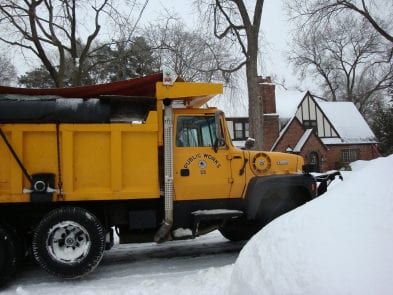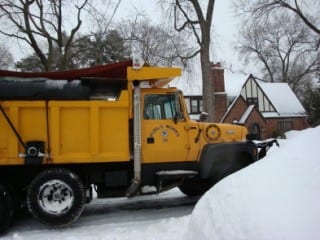West Hartford Department of Public Works Prepares for Winter

Audio By Carbonatix

We-Ha.com file photo
Leaves are being picked up and the storage shed is full of salt, purchased off-season at a discount.

Is this in the near future? Photo credit: Ronni Newton
By Ronni Newton
It’s not even Thanksgiving, but Buffalo is already buried under 5 feet of snow with more on the way. There was a dusting of snow on the grass in parts of West Hartford last Friday morning, and some flurries over the weekend. And it’s certainly been cold the past few days.
Winter is upon us.
West Hartford Department of Public Works Director John Phillips said crews were prepared just in case roads needed to be treated last Friday morning (they didn’t), but at this time of year the department routinely begin to transition to winter anyway.
Leaf pick-up is still a priority, and Phillips said that Public Works crews are collecting bagged leaves on a daily basis. The middle weeks of November typically have the highest volume of bags to collect, he said, but the 10-week program will continue through Dec. 26.
“Other DPW crews are out performing punch list work or any small maintenance projects that are short in duration. The asphalt plants close for the season in early December, as long as the weather holds out and it doesn’t snow,” Phillips said. They are trying to complete as many construction projects as possible before winter weather interferes.
It likely won’t be long before a “weather event” necessitates treating the roads, and Phillips said that the Department of Public Works is ready for the upcoming season.
“Preparation for this winter actually began last June. DPW strategically purchased 1,000 tons of our treated salt material anticipating a price increase. That order filled our storage shed with over 3,000 tons of treated salt for this season. With the well-publicized salt shortages last year, being prepared took on stronger meaning this year. Nationwide the price of salt has increased 15 to 25 percent, and some areas of the nation saw 40 percent increases,” Phillips said.
With what is already on hand, Phillips is confident that West Hartford will not experience any shortage of road salt. Crews typically apply about 4,500 tons of salt during the winter months.
Phillips has also strategized to keep the cost of treating West Hartford’s roads as low as possible, by using white salt – which is less expensive – rather than treated salt whenever possible.
“White salt works just as effectively in winter storms where the temperature hovers between 29 and 32 degrees. Treated salt is more effective at much lower temperatures. So when the storm temperature stays at or about 30 to 32 degrees, we will disburse the less expensive white salt instead of the treated salt normally used to de-ice our roads,” Phillips said.
Crews use as much as 500 tons in a long-duration storm, and Phillips said that depending on the temperature, using white salt could save the town thousands of dollars.
The snow plow fleet is also ready for winter. Most of the town’s plows are more than 20 years old, Phillips said, but all have been inspected and several were refurbished with new springs and patch welding which is far more cost effective than purchasing new equipment. According to Phillips, a new plow alone costs as much as $10,000.
Many of the trucks in the Department of Public Works plow fleet are also more than 20 years old, and they budget to replace at least one per year, Phillips said. One new truck has been added this year.
“The new trucks have advanced technology for us to better manage our cost control measures such as our salt material’s application rates. More importantly, each new truck is better for the driver’s safety. Advanced and modernized truck cabs create a more comfortable work environment that in return helps reduce driver fatigue. Also, new technologies in diesel engines help reduce emissions and fuel consumption rates,” said Phillips.
While it’s fun to predict the harshness of the winter by the bushiness of the squirrels’ tails or the width of the brown segments on woolly bear caterpillars, not even the best meteoroligist can accurately forecast right now what the winter will be like.
“Mother nature does not take requests, but we are ready for whatever she sends our way today, tomorrow, and throughout the winter months,” Phillips said.



